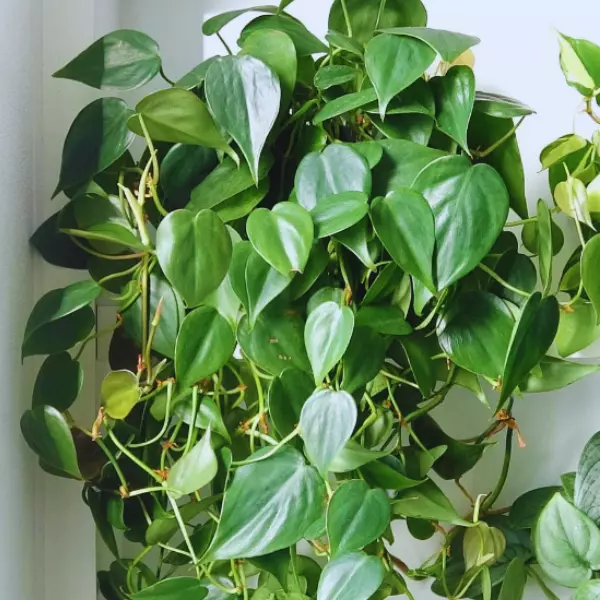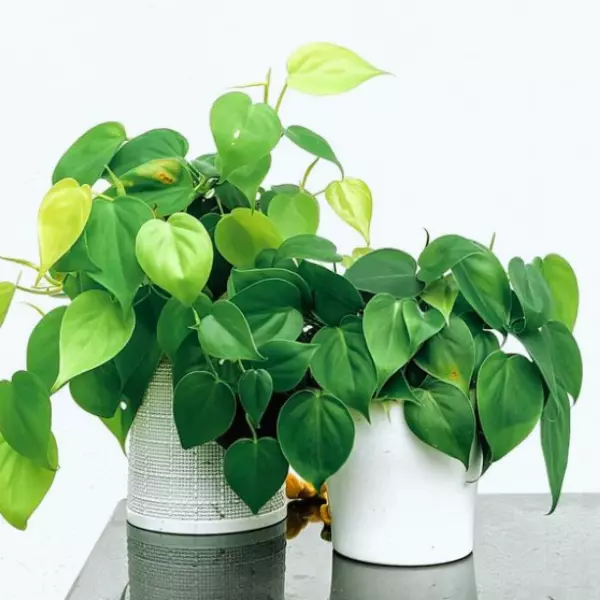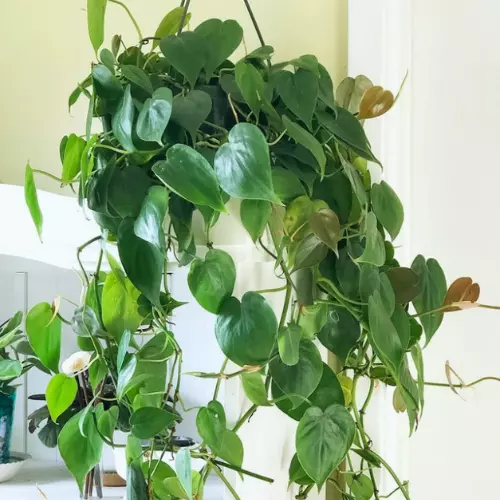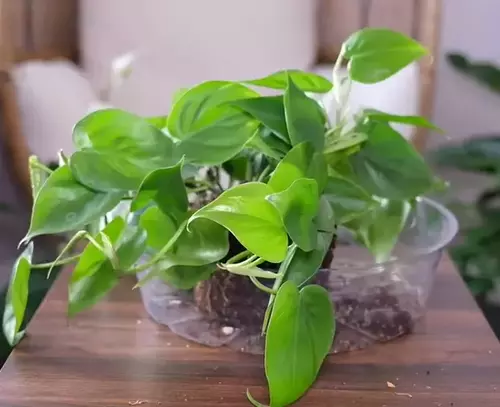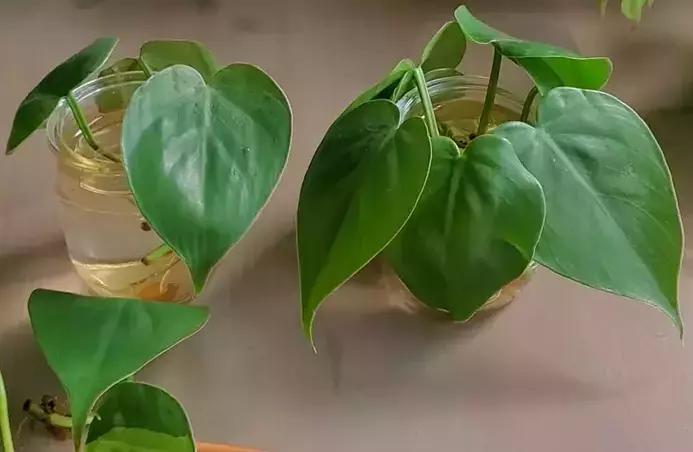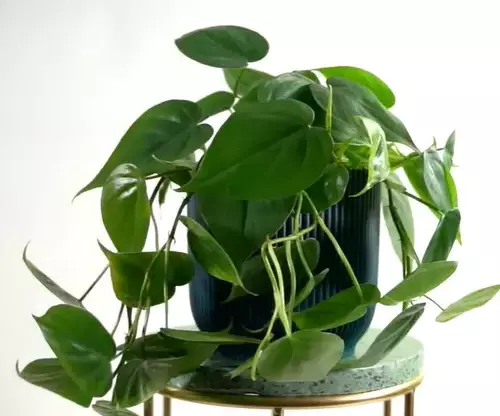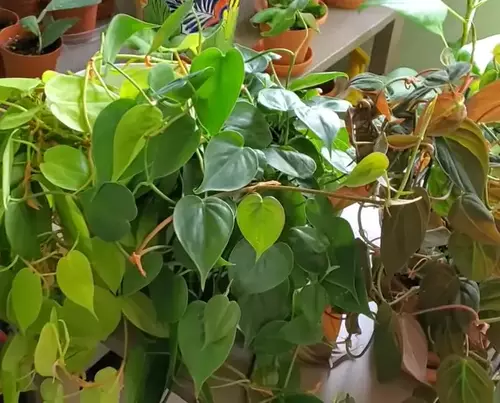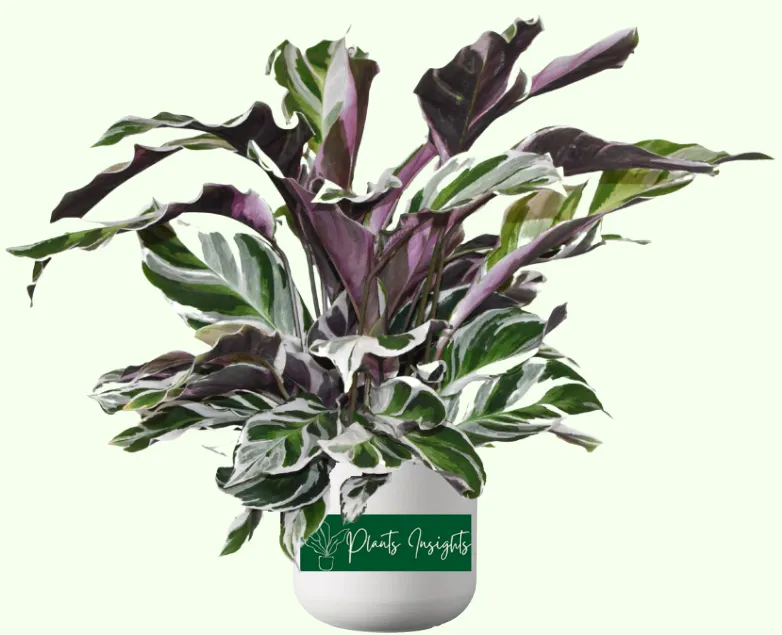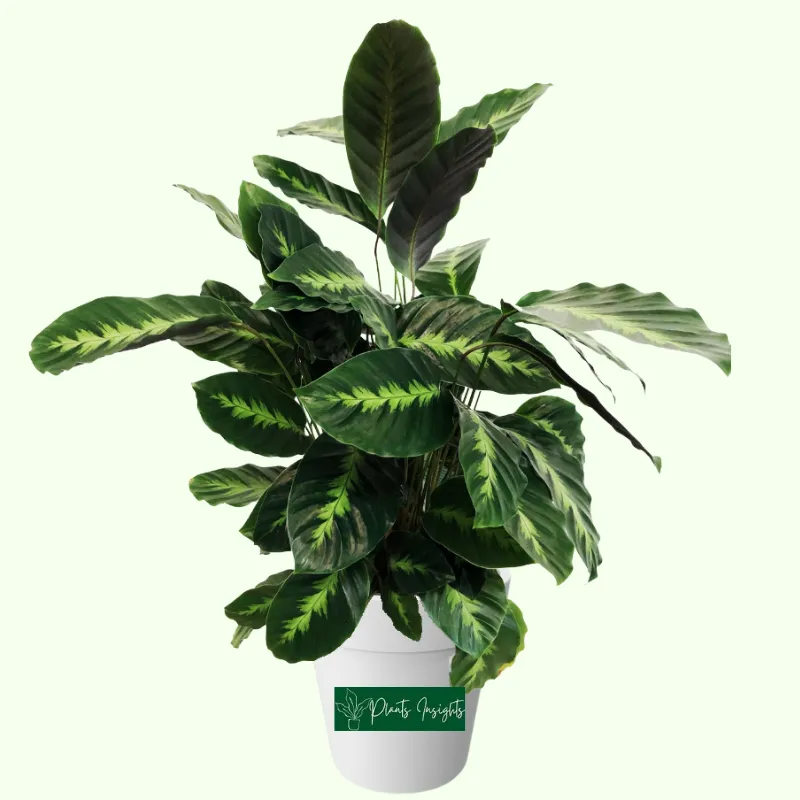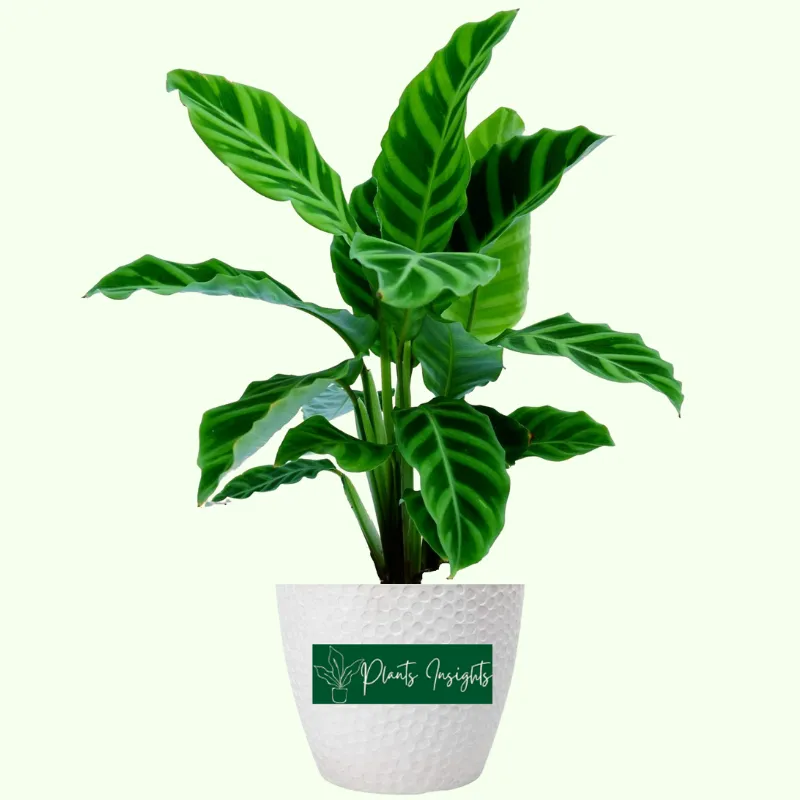Philodendron Scandens, often called the “Heartleaf Philodendron” or the “Sweetheart Plant” earns its evocative namesake through its captivating physical attributes. This perennial vine exhibits heart-shaped leaves that dangle delicately from slender and wiry stems. These leaves, adorned in glossy shades of deep green, possess a remarkable sheen, reflecting light like precious gemstones in the dappled sunlight of its native habitat. Belonging to the family Araceae, this enchanting plant hails from the tropical rainforests of Central and South America, where it thrives amidst the verdant canopies, adding an emerald touch to the thriving biodiversity.
Philodendron Scandens has an inherent charm that is both timeless and alluring. Its vines adorn homes and gardens alike, while its resilience in adapting to various environments adds to its undeniable allure. With an aesthetic so pleasing, it’s no wonder that this exquisite plant has captured the hearts of plant enthusiasts and interior decorators.
Closely-Related Allied Species: Philodendron Moonlight, Philodendron White Knight, Philodendron White Princess, Philodendron Splendid, Philodendron Verrucosum, Philodendron Pastazanum, Philodendron Squamiferum, Philodendron Lemon Lime
Essential Products
Origin and Family
| Botanical Name: | Philodendron Hederaceum |
| Family Name: | Araceae |
| Other names: | Heartleaf Philodendron |
| Plant Type: | Cascading /climbing perennial |
| Origin: | Central and South America |
| Color: | Dark green |
| Leaf Shape | Heart-shaped leaves |
| Humidity: | 40% to 60% |
| Temperature: | 65°F to 80°F (18°C to 27°C) |
| Light Need | Medium Indirect Light |
| Propagation | Stem cutting |
| Soil type | Loose, Well-Draining Soil |
| Diseases | Root rot, Leaf spot, and Stem rot |
| Pests | Spider mites and Mealybugs |
How do you Take Care of a Philodendron Scandens?
Caring for the Philodendron Scandens is a delightful endeavor, and it’s well-suited for both seasoned plant enthusiasts and beginners alike.
Known for its adaptability and forgiving nature, this charming plant requires little more than a loving touch and a few fundamental essentials: a bright, indirect light source, occasional watering, and well-draining soil.
This article will discuss every aspect of Philodendron Scandens care, including repotting, propagation, and common problems that your Philodendron Scandens may encounter! Keep reading to learn about the comprehensive care guide for this striking houseplant.

What conditions do Philodendron Scandens like?
Philodendron scandens thrive in moderate to bright, indirect light. They prefer well-draining soil and moderate humidity. Allow the soil to dry out slightly between waterings, and water sparingly in winter. Keep them at temperatures between 65-80°F (18-27°C) and provide occasional fertilization during the growing season for optimal growth.
Is Philodendron Scandens a climber or crawler?
‘Heartleaf Philodendron‘ or Philodendron Scandens is either a climber or trailing plant. It is grown to decorate the home as a climbing or hanging plant much like Pothos and Philodendron Lemon Lime. Sweatheart plant can climb by means of aerial roots, and plants grown outdoors can reach enormous heights using tall trees trunk as support.
Is Philodendron Scandens a fast grower?
The evergreen beauty Philodendron Scandens is a moderate grower and in ideal conditions, the heartleaf philodendron can grow between 3 and 6 metres long in few years. In addition, the leaves of outdoor plants grow many times larger than indoor plants.

Light Requirements for Philodendron Scandens
Heartleaf Philodendron is renowned for its adaptability to various lighting conditions. It thrives in bright, indirect light, making it an excellent choice for homes and offices with filtered or dappled sunlight. This adaptable nature makes it a great option for those with different lighting situations.
While the Philodendron Scandens can tolerate brief exposure to indirect sunlight, it is not well-suited for prolonged direct sunlight. Direct sunlight can scorch its leaves, causing them to develop unsightly brown patches. To keep your plant healthy and vibrant, avoid placing it in direct sunlight for extended periods.
Ideally, place your Philodendron sweetheart near a window with filtered or diffused sunlight. East or north-facing windows are often perfect spots, as they provide bright but indirect light. If you have a west or south-facing window, ensure the plant is positioned away from the direct rays of the sun or use sheer curtains to filter the light. You can also grow this plant under artificial lighting, such as fluorescent or LED grow lights, if natural light is limited.
Exposure to high-intensity light has some adverse effects on this plant because if this philodendron receives too much direct sunlight, you may notice brown or scorched patches on the leaves. Also, overexposure to intense light can cause the leaves to curl or fold inward as a protective measure.
Effect of Low Light
Lack of light can also negatively affect this plant, like it may become leggy with long, stretched stems with long internode spacing and sparse foliage. Insufficient light can also cause the lower leaves to turn yellow and eventually drop.
Moreover, low light exposure means the plant will not photosynthesize efficiently and won’t absorb the soil’s complete water, which may cause root rot.
To ensure the well-being of your Philodendron Scandens, find that perfect balance of bright indirect light and monitor its response to its placement. With proper lighting care, your plant will flourish, displaying its lush, heart-shaped leaves in all their vibrant glory.
If you don’t have a bright spot at your place, using grow lights helps achieve the required light.


Humidity
Philodendron Scandens thrives in moderate to high humidity levels, mimicking its native tropical environment. It enjoys a humidity range of around 40% to 60%, which is relatively easy to achieve in most indoor settings.
Always keep the required humidity level of this heartleaf Philodendron as insufficient humidity can lead to several issues for your Philodendron Scandens, including brown leaf tips, stagnant growth and increased susceptibility to pests.
To increase humidity around your Philodendron Scandens, you can use a humidifier near your plant to maintain consistent high humidity levels.
Plus, spritzing the plant with water regularly can help elevate humidity locally. You can also group your philodendron Scandens with other plants, as grouping can create a microclimate with higher humidity. Placing trays of water near the plant is another effective method for raising humidity levels.
Temperature
Philodendron Scandens thrives in temperatures between 65°F to 80°F (18°C to 27°C) as it prefers a warm and stable environment. Exposure to temperatures below 50°F (10°C) can slow down the plant’s growth and make it more susceptible to cold damage, which may result in leaf yellowing and browning.
In contrast, high temperature is also not good for the well-being of Philodendron Scandens as prolonged exposure to temperatures above 90°F (32°C) can stress the plant, causing its leaves to wilt, dry out, or even scorch.
Sudden temperature fluctuations, especially drastic drops, can shock the Philodendron Scandens. This shock may lead to a temporary decline in growth and overall health. It’s best to shield your plant from drafts and sudden temperature changes, ensuring it remains in a stable and comfortable environment.
Bring this plant indoors in the fall when the temperature drops below 50F at night. Moreover, using heating pads and frost blankets during winter helps maintaining the optimal temperature.
By providing your Philodendron heartleaf with the appropriate humidity levels and maintaining a stable temperature range, you can help ensure its lush foliage and overall well-being.

Watering
Philodendron Scandens, with its easygoing nature, has relatively simple watering requirements. During the growing season, which typically spans spring and summer, it thrives when kept moderately moist but not soggy. Water the plant thoroughly when the top inch (2.5 cm) of the soil feels dry to the touch. Ensure that excess water can drain freely from the pot to prevent root rot.
In contrast, during the dormant period in fall and winter, the plant’s water requirements decrease. Allow the top 2 inches (5 cm) of soil to dry out before watering. This extended dry period mimics its natural habitat’s seasonal changes and helps maintain the plant’s health.
How to Determine soil Moisture?
Therefore, the best watering technique is to let the topsoil dry between the watering sessions. The ideal method to determine the dry soil is to dip fingers in it and check the moisture. Using a moisture meter or moisture sensor is quite helpful in examining soil desiccation if you are not sure. Once the top soil dries, water your plant thoroughly, and wait until the excess water drains out from the drainage holes to prevent any root rot or fungal disease.
Repercussions of Overwatering and Symptoms:
Overwatering can lead to root rot, a common issue for heartleaf Philodendron. Symptoms include yellowing, wilting, and drooping leaves, as well as the presence of mould or a foul odour in the soil. The roots may become mushy and brown. To remedy overwatering, allow the soil to dry out, and consider repotting if the root rot is severe.
Result of Underwatering and Symptoms:
Underwatering can cause the sweetheart plant to become stressed and wilt. Its leaves may turn brown at the tips and edges, and the plant may lose some of its vitality. To rectify underwatering, water the plant thoroughly and ensure proper humidity levels, especially in dry indoor environments.
Specific Water Requirements:
The Philodendron Scandens appreciates slightly acidic to neutral water. Using distilled or rainwater is ideal, as it helps avoid mineral buildup in the soil over time. If tap water is your only option, allow it to sit out for a day to allow chlorine and other chemicals to dissipate before using it to water your plant. Maintaining proper moisture levels in the soil is crucial, but always remember to avoid waterlogged conditions.

Soil Requirement
The soil mix for Philodendron Scandens should be well-draining to prevent waterlogged conditions, which can lead to root rot. Good drainage allows excess water to escape, keeping the roots healthy.
While it should drain well, the soil mix should also retain some moisture to keep the plant adequately hydrated. In addition, adequate aeration is crucial to prevent compaction of the soil, which can hinder root growth and overall plant health.
The soil mix should also be nutrient-rich to provide essential nutrients for the plant’s growth and development. Also, the ideal pH level for Philodendron Scandens is slightly acidic to neutral, with a range of 6.0 to 7.0. This pH range guarantees that the plant can absorb nutrients efficiently from the soil.
You can create a suitable soil mix for Philodendron Scandens using the following constituents and their approximate ratios:
- House plant potting mix 25%
- Orchid bark 25%
- Perlite or Vermiculite 25% (for improved drainage)
- Coco Coir or Peat Moss 15 % (to retain moisture)
- Worm castings 10% (add richness to the soil)
- Charcoal ( for drainage)
Mix these components thoroughly to create a well-balanced and nutrient-rich soil mix for your Philodendron Scandens.
Besides that, you can also choose from our recommended potting mixes available in the market, such as:

Philodendron Hederaceum Propagation
Since Heartleaf Philodendron is a trailing plant with aerial roots and multiple growth points or nodes similar to Philodendron Lemon Lime, it can easily be propagated via stem cuttings with 99% success rate.
Stem Cutting Propagation
Philodendron Hederaceum doesn’t go dormant, so you can attempt to propagate any time of the year.
Follow a step-by-step guide to propagating Neon Philodendrons via stem cutting.

Heartleaf Philodendron Repotting
Repotting your Philodendron Scandens is necessary when it becomes root-bound or outgrows its current container. Signs that your plant may need repotting include roots emerging from the drainage holes, reduced growth, or the plant becoming top-heavy and unstable in its pot. Typically, you might need to repot it every 1 or 2 years, depending on its growth.
The best time to repot your Philodendron heartfelt is in the spring, just before or at the beginning of the active growing season. This allows the plant to recover and establish itself in its new pot when growth is most vigorous.
Step-by-Step Instructions for Repotting:
Materials You’ll Need:
- A slightly larger pot with drainage holes.
- Fresh potting mix suitable for Philodendron Scandens (as mentioned earlier).
- Pruning shears or scissors.
- A trowel or gardening gloves.
Procedure:
- Select a new pot that is 1-2 inches (2.5-5 cm) larger in diameter than the current one. Make sure it has drainage holes to prevent waterlogged soil.
- Place a small piece of fine mesh or a coffee filter over the drainage holes to keep the soil from escaping while allowing water to drain freely.
- Water your Philodendron Scandens a day or two before repotting. This makes it easier to remove the plant from the old pot and reduces stress.
- Gently tap the old pot to loosen the plant and carefully slide it out, supporting the base of the plant with your hand.
- Check the roots for any signs of damage or rot. Trim away any dead or rotting roots with clean, sharp pruning shears or scissors. This step encourages healthy root growth.
- Place a layer of fresh potting mix in the bottom of the new pot so the plant’s base sits at the desired height. Make a small well in the centre to accommodate the plant.
- Position the Scandens in the new pot, ensuring it’s at the same depth as it was in the old pot. Fill in the space around the plant with more potting mix, gently pressing it down to eliminate air pockets.
- After repotting, water the plant thoroughly. This helps settle the soil and hydrates the roots.
- Place the newly potted Scandens in a location with bright, indirect light and allow it to recover. Avoid fertilizing for a few weeks to reduce stress on the plant.
Repotting your heartfelt Philodendron as needed guarantees that it has enough space for healthy root growth and provides a fresh supply of nutrients from the new potting mix, promoting vigorous growth and vitality.

Fertilizing
Philodendron Scandens benefits from periodic fertilization to support its growth and overall health. Fertilizers provide essential nutrients that may become depleted over time in the potting mix. Therefore, fertilize your heartfelt Philodendron during the active growing season, which typically spans from spring through early fall. Avoid fertilizing during the dormant period in late fall and winter when the plant’s growth slows down.
Fertilize your Scandens approximately every 4-6 weeks during the growing season. This interval provides a consistent supply of nutrients without overdoing it. For this you can use a balanced, water-soluble, all-purpose houseplant fertilizer with a formulation such as 20-20-20 or 10-10-10. These fertilizers contain a balanced ratio of essential nutrients, including nitrogen (N), phosphorus (P), and potassium (K), which are crucial for plant growth.
Use the diluted fertilizer solution to water your Scandens. Apply the solution evenly across the soil surface until it starts to seep out from the drainage holes. Ensure that you thoroughly saturate the soil. Also, be careful not to get fertilizer on the plant’s leaves, as this can lead to leaf burn. If any fertilizer does accidentally touch the leaves, gently wipe it off with a damp cloth.
If you are new to plant parenting I highly recommend trying Miracle-Grow Indoor Plant Food Spikes. These pellets are really easy to use and will not burn any foliage of your plant.
Over-fertilization
Over-fertilization can harm your Philodendron Scandens and lead to various issues:
Fertilizer Burn: Excess fertilizer can cause the tips and edges of leaves to turn brown or black, a condition known as fertilizer burn.
Salt Buildup: Accumulation of salts in the soil from excessive fertilizer use can damage roots and hinder nutrient absorption.
Reduced Growth: Paradoxically, over-fertilization can inhibit growth and weaken the plant.
On the other hand, if you under-fertilize your Heartleaf Philodendron, it may exhibit slow growth and pale or yellowing leaves. The plant may also become more susceptible to nutrient deficiencies.
Balanced and regular fertilization will help your Philodendron Scandens maintain its vibrant, lush foliage and promote healthy growth.
Here are some good fertilizers for your Philodendron available on the market:
- Philodendron Plant Food, Indoor Plant Food Liquid Fertilizer
- Liqui-Dirt Nano Powder All-Purpose Organic Plant Food
- Osmocote Smart-Release Plant Food
Be careful with the usage, as over-fertilization may burn the plant.

Pruning and Maintenance
Philodendron Scandens is a low-maintenance plant that makes it a popular choice for both novice and experienced gardeners. Here are some key maintenance tasks to keep your plant healthy and thriving:
Pruning:
Regular pruning is not essential, but it can help maintain the plant’s shape and encourage bushier growth. Prune away any leggy or unruly stems to encourage new growth from the base. You can also trim dead or yellowing leaves to keep the plant looking tidy and vibrant.
Moreover, you can propagate the cuttings and replant them in the pot to make the plant bushier.
Cleaning:
The glossy leaves of the Philodendron Scandens can accumulate dust over time. Wipe the leaves gently with a damp cloth or sponge to remove dust and allow the plant to photosynthesize efficiently. Occasionally, you can give your plant a gentle shower to clean the leaves and provide it with a refreshing misting.
Upkeep Level:
Philodendron Scandens is considered a low-maintenance plant. It is forgiving of occasional lapses in care and can tolerate some neglect. Regularly check the soil moisture and water when the top inch (2.5 cm) is dry during the growing season, and adjust watering during the dormant period.
Ensure proper lighting conditions, as mentioned earlier, to maintain its lush appearance, watch for signs of pests and take action if necessary. Common pests for this plant include spider mites and mealybugs, which can be treated with insecticidal soap or neem oil.
By following these simple maintenance practices, you can enjoy the beauty of your Philodendron Scandens with minimal effort. Its ability to thrive under various conditions and its forgiving nature makes it an ideal choice for any space.

Toxicity
Philodendron Scandens, like many other members of the Araceae family, contains compounds that can be toxic if ingested, and its sap can irritate the skin and mucous membranes. Here’s what you need to know about its toxicity:
Ingestion:
All parts of the Philodendron Scandens plant, especially the leaves and stems, contain calcium oxalate crystals, which can cause irritation and discomfort if ingested. Symptoms of ingestion may include oral burning, swelling, drooling, and difficulty swallowing. In more severe cases, it can lead to nausea, vomiting, and digestive upset. While not usually life-threatening, it’s essential to seek medical attention if significant ingestion occurs, especially in children or pets.
Skin and Eye Contact:
The plant’s sap can also be irritating to the skin and eyes. Contact with the sap may cause redness, itching, and skin irritation. If the sap gets into the eyes, it can result in pain, redness, and temporary vision disturbance. Rinse the affected area thoroughly with water if contact occurs and seek medical attention if irritation persists.
Keep Out of Reach of Children and Pets:
Due to its toxic properties, it’s advisable to keep Philodendron Scandens out of the reach of children and pets who may be tempted to chew on its leaves or stems.
Caution During Handling:
When handling the plant, it’s a good practice to wear gloves to avoid skin contact with the sap. Additionally, wash your hands thoroughly after working with the plant.
Despite its toxicity, many people successfully grow Philodendron sweetheart in their homes by taking precautions and ensuring that it’s not accessible to children or pets who may be prone to exploring and tasting plants. Being aware of its potential toxicity and practicing safety measures can help you enjoy the beauty of this plant without concerns.

Diseases & Pests
Common Pests:
Spider Mites: These tiny arachnids can infest the undersides of leaves, causing stippling, webbing, and a generally unhealthy appearance. To counter spider mites, regularly mist your plant to increase humidity, and use insecticidal soap or neem oil to control the infestation.
Mealybugs: Mealybugs are small, white, cottony insects that cluster on the leaves and stems. To combat them, you can use a cotton swab dipped in rubbing alcohol to remove them manually, or treat the plant with insecticidal soap or neem oil.
Scale Insects: Scale insects can attach themselves to the stems and leaves of Philodendron scandens, forming hard, waxy shells. You can gently scrape them off with a soft brush or cloth and treat the plant with neem oil or insecticidal soap.
Aphids: Aphids can colonize the tender new growth of your plant, causing leaves to become distorted and yellow. To control aphids, use a strong stream of water to dislodge them, or apply insecticidal soap.
Diseases
Root Rot: Root rot is a fungal disease caused by overwatering or poorly draining soil. To prevent it, ensure the plant’s pot has proper drainage and water only when the top inch of soil is dry. If root rot occurs, trim affected roots, repot the plant in fresh soil, and reduce watering.
Leaf Spot: Leaf spot diseases, often caused by fungal pathogens, can result in brown or yellow spots on the leaves. Remove affected leaves, improve air circulation around the plant, and avoid overhead watering to prevent leaf spots.
Common Problems:
Leggy Growth: If your Philodendron heartfelt starts to grow long, thin stems with sparse foliage, it may not be receiving enough light. Prune leggy growth and provide brighter, indirect light to encourage bushier growth.
Yellowing Leaves: Yellowing leaves can be a sign of various issues, including overwatering, underwatering, nutrient deficiencies, or pest infestations. Address the underlying cause by adjusting watering, fertilizing, or treating pests as needed.
Slow Growth: Slow growth can result from poor lighting, inadequate nutrients, or root-bound conditions. Ensure your plant is in suitable lighting conditions, fertilize as recommended, and repot if it has outgrown its pot.
Regularly inspect your Philodendron Scandens for signs of pests, diseases, or other issues, and take prompt action to address them. Maintaining a healthy growing environment with proper care and attention will help your plant thrive and remain vibrant.

Common Queries
Can Philodendron Scandens take direct sunlight?
Heartleaf Philodendron prefers bright, indirect sunlight. Direct sunlight can scorch its leaves, so it’s best to place it in a location with filtered or dappled sunlight. It can tolerate some morning sun, but avoid harsh afternoon sun to keep it healthy and vibrant.
Does Philodendron need full sun?
Philodendrons, including Philodendron Scandens, do not need full sun. They prefer moderate to bright, indirect sunlight. Full sun can burn their leaves, so it’s best to provide them with filtered or dappled sunlight to keep them healthy and thriving.
Can Philodendron grow in water only?
Many Philodendron varieties, including the Heartleaf Philodendron, can be grown in water. This method is known as “water propagation.” You can place a healthy stem cutting with nodes in a container of water and allow it to root. However, for long-term growth, it’s a good idea to eventually transplant it into soil to provide more nutrients and stability for the plant.
Does Philodendron like rain?
Philodendrons are tropical plants that often benefit from occasional rain. Rainwater can help flush out accumulated salts and dust from their leaves and provide them with a source of natural hydration. However, it’s important to ensure good drainage in their pots or soil to prevent waterlogged roots, as overwatering can be detrimental to the plant’s health. If growing them indoors, occasional misting can mimic the beneficial effects of rain.

Conclusion
In the lush world of indoor and outdoor greenery, the Philodendron Scandens stands as a true gem. Its emerald heart-shaped leaves reflect the beauty of its tropical origins, and its adaptability makes it an ideal companion for all types of gardeners.
With some love and attention, this charismatic plant will become not just a botanical addition but a cherished member of your family, enhancing your space with its timeless grace. So, let your gardening journey flourish with the vibrant presence of the Philodendron Scandens, a green friend that’s sure to steal your heart.
Related Posts
Calathea Musaica | Network Calathea Care Guide
Calathea Musaica is also famous as famous as Network Calathea due to its characteristic mosaic pattern like a complex network on its foliage.
Calathea Fusion White Care Guide
Calathea Fusion White is a gorgeous but difficult plant with white color fusing with green on glossy leaves and purple color undersides.
Calathea Louisae Maui Queen Care Guide
Calathea Louisae also known as Calathea Maui Queen require little care to be an adoring, colorful plant boasting exotic beautiful foliage.
Calathea Zebrina | Calathea Zebra Plant Care Guide
Calathea Zebrina, the Zebra plant is a plant with dark green velvety leaves and lime green stripes giving it a pattern look of Zebra.
Rattlesnake Plant | Calathea Lancifolia Care Guide
Calathea Lancifolia gets the nickname of Rattlesnake plant due to the markings on the leaves that resemble rattle snakeskin patterns.

